Climate change is dramatically impacting coffee production by altering the environmental conditions necessary for growing high-quality beans. Rising temperatures could halve suitable land for coffee cultivation by 2050, while unpredictable rainfall leads to droughts or excessive moisture, inviting pests and diseases. These changes threaten yields, pushing farmers into debt and destabilizing communities. To adapt, innovative farming practices and technologies are emerging. If you’re curious about how these solutions can help, there’s much more to discover.
Key Takeaways
- Climate change is projected to reduce suitable land for coffee cultivation by half by 2050, affecting both Arabica and Robusta species.
- Rising temperatures and unpredictable rainfall increase crop vulnerability to pests and diseases, leading to reduced coffee yields.
- Global coffee production could decrease by up to 50% by 2050, raising production costs and potentially increasing consumer prices.
- Economic instability from lower yields threatens farmers’ livelihoods, pushing them towards debt and urban migration, which affects cultural heritage.
- Sustainable practices and innovations, such as drought-resistant varieties and precision agriculture, are essential for mitigating climate impacts on coffee farming.
Understanding Coffee and Its Origins
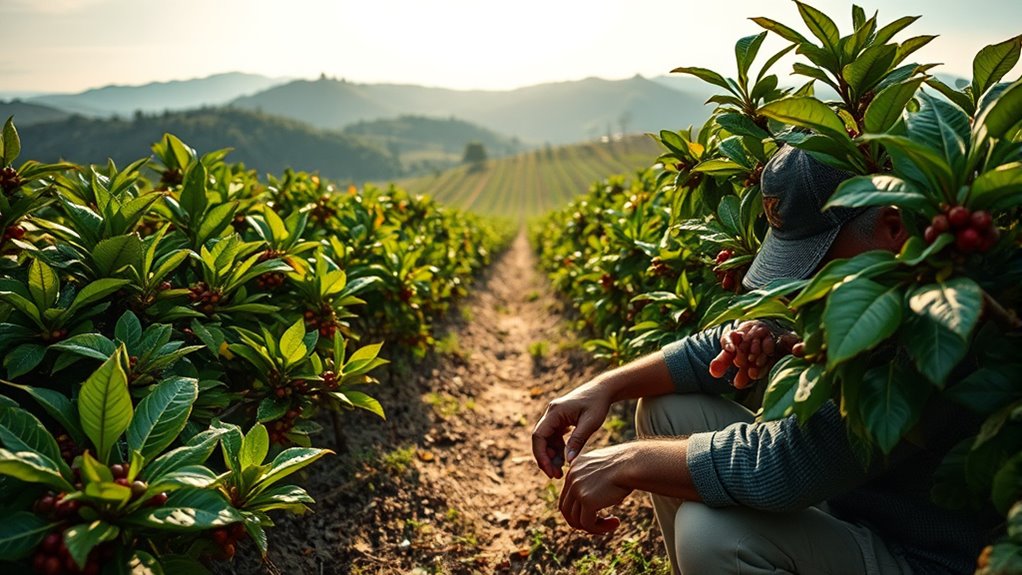
When you sip your morning coffee, you’re enjoying a beverage with deep roots in history and geography.
Coffee originates from the Coffea plant, primarily found in the Coffee Belt around the equator. The two main species are Arabica and Robusta, with Arabica accounting for about 70% of global coffee production.
Coffee comes from the Coffea plant, mainly in the equatorial Coffee Belt, with Arabica making up 70% of the world’s supply.
Arabica thrives in cooler, higher altitudes, while Robusta grows in warmer, lower areas and has a more bitter taste due to its higher caffeine content.
Each coffee tree yields around 10 pounds of coffee cherries, which translate to about 1-2 pounds of coffee beans after processing. These cherries take about a year to mature, and the trees can take up to five years to reach full production levels, making coffee cultivation a true commitment.
The Anatomy of Coffee Beans
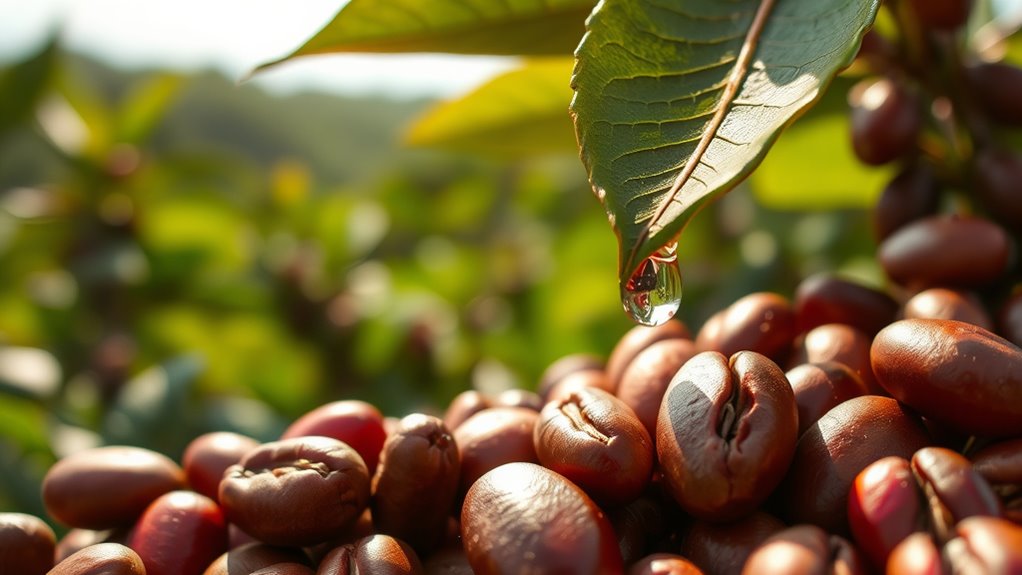
When you look at a coffee cherry, you’ll notice it has multiple layers, each playing a role in the flavor of the beans inside.
You might be surprised to learn that most cherries hold two beans, while some contain a unique Peaberry.
Understanding these layers and the different bean varieties can really enhance your appreciation for your morning cup.
Coffee Cherry Layers
The anatomy of coffee cherries reveals a fascinating structure that plays an essential role in the quality and flavor of your morning brew. Each cherry consists of multiple layers: the Exocarp (outer skin), Mesocarp, and Endocarp (parchment), all protecting the precious coffee beans inside.
Typically, two beans reside in each cherry, but about 5% yield a single, smaller Peaberry. The Arabica species thrives in cooler, higher elevations, while the Robusta species prefers warmer, lower regions, each impacting flavor profiles differently.
Environmental conditions greatly influence these cherries, ultimately affecting coffee production. With climate change altering these conditions, the intricate layers of coffee cherries might struggle to maintain the quality and flavors you love in your cup.
Bean Varieties and Types
While exploring coffee bean varieties, you’ll discover that the seeds of coffee cherries come in two main species: Arabica and Robusta.
Arabica accounts for about 70% of global coffee production, thriving in higher altitudes with ideal growing conditions. Its flavor profile is typically sweeter and more complex.
On the other hand, Robusta beans grow in warmer regions, are more bitter, and contain higher caffeine levels.
Climate change is affecting these coffee crops, altering the environments essential for each species’ growth. Additionally, various subgroups, including Bourbon and Typica, arise from selective breeding and hybridization, adapting to shifting conditions.
Understanding these bean varieties helps you appreciate how climate change impacts coffee production and ultimately your daily cup.
Species and Varieties of Coffee
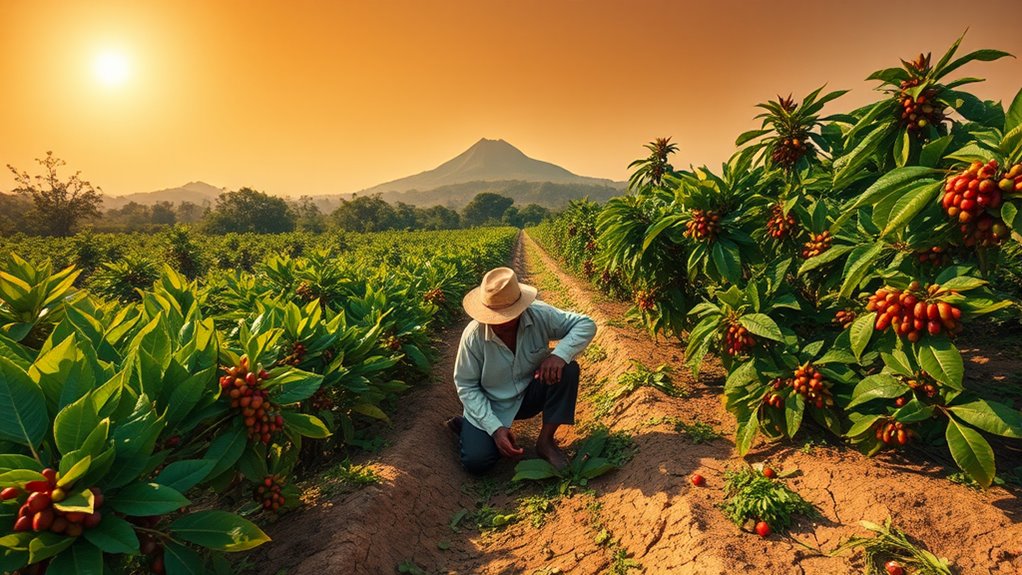
Understanding the different species and varieties of coffee is essential for appreciating its diverse flavors and characteristics. The two primary species are Arabica and Robusta. Arabica thrives in higher altitudes, producing about 70% of global coffee production, and is celebrated for its complex flavors.
In contrast, Robusta grows in warmer, lower altitudes, known for its higher caffeine content and resilience to pests. Within Arabica, you’ll find varieties like Bourbon and Typica, while Robusta features less diversity with Conilon and Kouillou.
Climate change impacts growing conditions, affecting these varieties’ adaptability. As you explore coffee, consider how each species and variety responds to these changes, influencing the coffee you enjoy every day.
The Coffee Belt and Its Importance
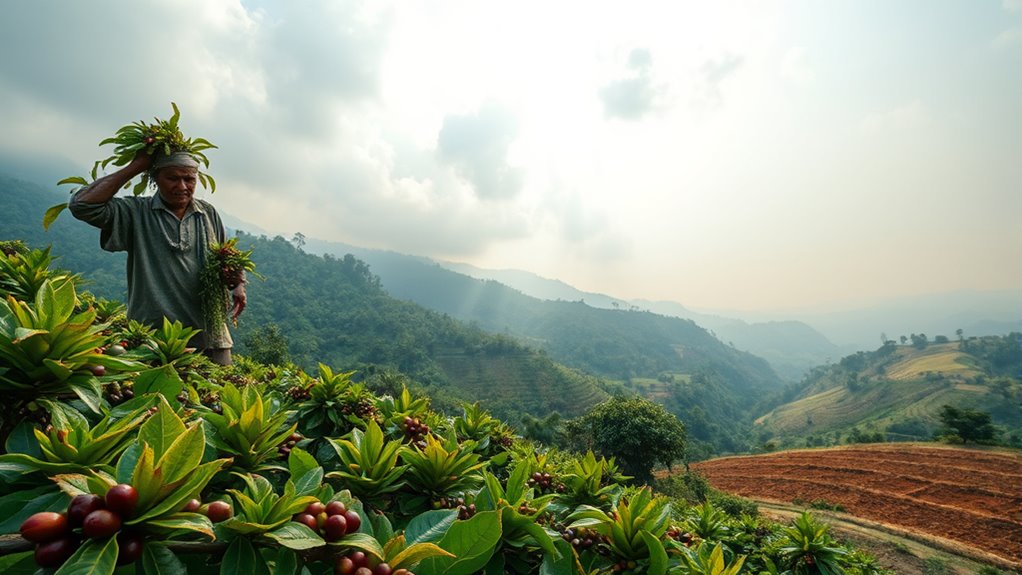
The Coffee Belt is essential for coffee lovers like you, as it provides the perfect conditions for growing high-quality beans.
With its rich soil and specific climate, this region supports diverse coffee species and flavors.
However, as climate change shifts these suitable areas, it’s important to understand how this impacts coffee production and what adaptations might be necessary.
Optimal Growing Conditions
Coffee thrives in the Coffee Belt, a vital region around the equator where ideal growing conditions come together. Here, coffee plants flourish at elevations of 2,000-6,000 feet, benefiting from mild temperatures and abundant rainfall. To maintain prime growing conditions, coffee plants need temperatures between 59-75 degrees Fahrenheit and about 60 inches of annual rainfall. Unfortunately, climate change disrupts these delicate balances, leading to erratic rainfall patterns and rising temperatures, which threaten coffee production and yields. By 2050, suitable land for coffee cultivation could halve, jeopardizing the future of your favorite brew.
| Factor | Requirement |
|---|---|
| Prime Temperature | 59-75°F |
| Annual Rainfall | 60 inches |
| Elevation | 2,000-6,000 feet |
Coffee Species Distribution
Situated in the heart of the Coffee Belt, coffee species distribution plays an essential role in determining where and how coffee is produced. This region, spanning Latin America, Africa, and Asia, offers ideal conditions for coffee cultivation, primarily supporting Arabica and Robusta species.
Arabica accounts for about 70% of global production, thriving at elevations between 2,000 and 6,000 feet where cooler temperatures enhance its complex flavors. However, climate change is shifting suitable growing regions, threatening these delicate ecosystems.
Countries like Brazil, Colombia, and Ethiopia face potential reductions in land available for coffee cultivation by 2050, risking the future of this beloved beverage. Understanding these shifts in coffee species distribution is imperative for securing high-quality coffee production.
Climate Sensitivity and Adaptation
While many mightn’t realize it, the Coffee Belt is vital for maintaining coffee production amidst climate change challenges. This region’s unique climate sensitivity means that rising temperatures and erratic rainfall patterns threaten suitable growing regions for coffee cultivation.
As farmers face increased risks of crop failure, adaptation becomes significant. They must adopt sustainable practices to cope with changing conditions, like shifting to higher elevations where cooler temperatures still prevail. However, this isn’t a permanent solution, as suitable land diminishes.
The Impact of Climate Change on Coffee Production

As climate change continues to reshape our environment, it’s becoming increasingly clear that coffee production is facing significant challenges.
Rising temperature increases threaten suitable growing conditions for both Arabica and Robusta, pushing them beyond their ideal ranges. You’re likely to notice changes in coffee supply as climate change could halve the land suitable for cultivation by 2050.
Unpredictable rainfall patterns lead to longer droughts or excessive rain, harming coffee plant health and growth. Additionally, the increased vulnerability to pests and diseases, fueled by warmer and wetter conditions, jeopardizes crop quality.
These factors not only threaten the future of your favorite brew but also raise production costs for farmers, ultimately impacting what you pay for coffee.
Economic Consequences for Coffee Farmers
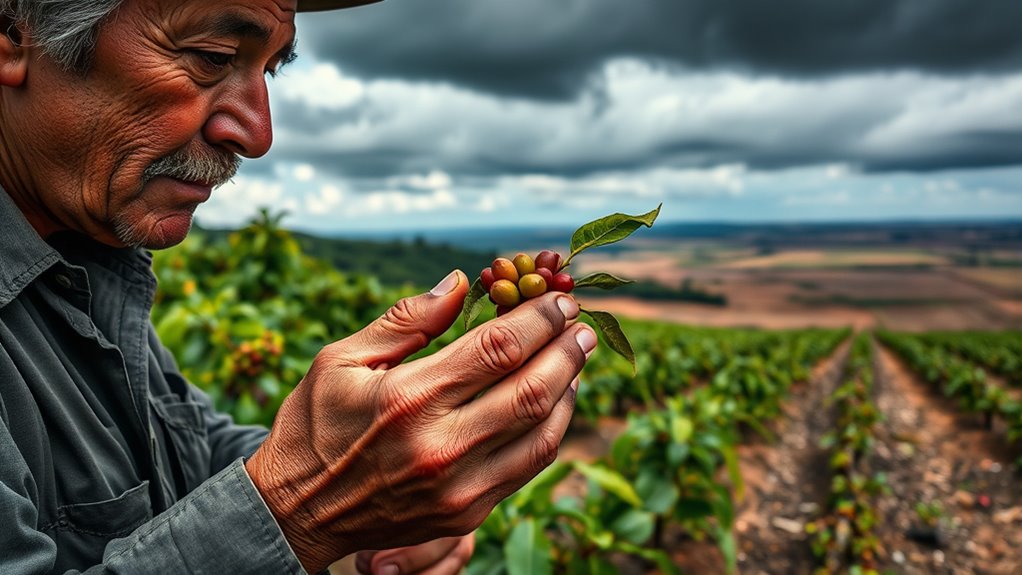
The economic consequences of climate change on coffee farmers are profound, threatening their livelihoods and the stability of entire communities.
As a coffee farmer, you might face several challenges due to climate change:
- Decreased Crop Yields: Projections indicate global coffee yields could drop by up to 50% by 2050, severely impacting your income as a smallholder farmer.
- Price Volatility: Economic instability from reduced yields leads to unpredictable coffee prices, complicating your financial planning.
- Rising Production Costs: Adapting to climate change can increase your costs, pushing you further into debt and jeopardizing sustainable farming practices.
These factors not only affect you but can also ripple through local economies, especially in coffee-dependent countries where coffee is a crucial export.
Social Implications for Coffee Communities
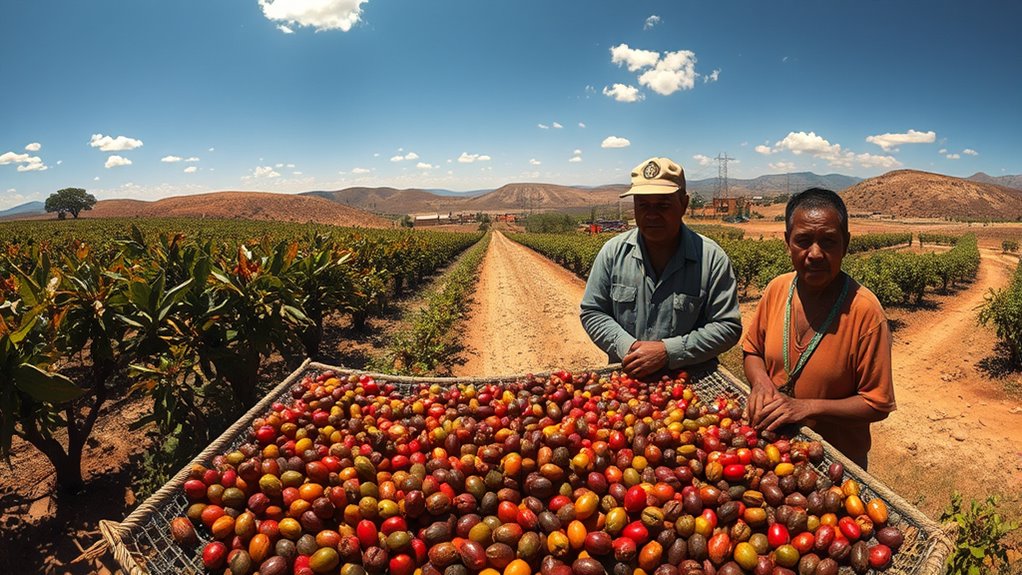
Climate change greatly impacts coffee communities, threatening not just livelihoods but also the very fabric of social structures.
As smallholder coffee farmers face reduced crop yields, financial instability becomes an alarming reality. In regions where coffee represents a substantial portion of the economy, like Ethiopia, climate impacts pose a significant economic concern. Increased production costs may push small farmers out of the market, leading to monopolization by larger businesses.
As farming becomes unsustainable, many rural farmers migrate to urban areas, eroding cultural heritage and traditional farming knowledge. This economic hardship can spark social instability, heightening issues like crime and political unrest.
Ultimately, the intertwined realities of climate change and coffee production jeopardize both community cohesion and cultural identity.
Innovations and Solutions in Coffee Farming
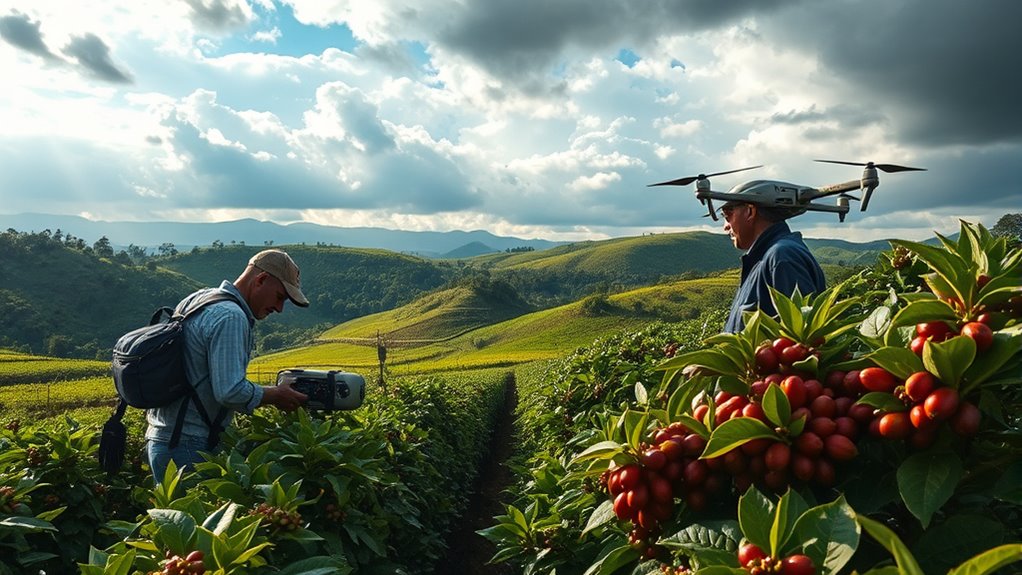
As climate change continues to impact coffee production, you’re likely looking for ways to adapt.
Innovations like drought-resistant coffee varieties and precision agriculture techniques can help you optimize your farming practices and guarantee resilient crops.
Drought-resistant Coffee Varieties
While traditional coffee-growing regions face increasing challenges from climate change, innovative solutions like drought-resistant coffee varieties are emerging.
These varieties are designed to help mitigate climate change effects, ensuring smallholder farmers can adapt to shifting environmental conditions.
Here are three key benefits:
- Enhanced Resilience: Drought-resistant coffee plants withstand prolonged dry periods, safeguarding quality and yield.
- Sustainable Farming: By reducing the economic burden on farmers facing climate-related challenges, these innovations promote sustainability in coffee production.
- Future Viability: With suitable land for coffee cultivation projected to decline by nearly 50% by 2050, these varieties offer a significant lifeline to maintain coffee supplies and farmer livelihoods.
Embracing these solutions is essential for the industry’s future.
Precision Agriculture Techniques
In today’s rapidly changing agricultural landscape, precision agriculture techniques are revolutionizing how coffee farmers manage their crops. By utilizing data-driven approaches, you can optimize irrigation, fertilization, and pest management based on real-time environmental conditions.
Technologies like GPS mapping and remote sensing enable you to monitor crop health and soil conditions, improving yields while reducing resource waste. Implementing precision agriculture enhances your resilience against climate change, allowing for adaptive management that responds to varying weather patterns.
Drones facilitate aerial monitoring of your plantations, helping you quickly identify pest infestations or diseases. By adopting these techniques, you can optimize water and fertilizer use, reduce costs, and maintain sustainable production levels, all while addressing the challenges posed by climate change.
Supporting Sustainable Coffee Practices
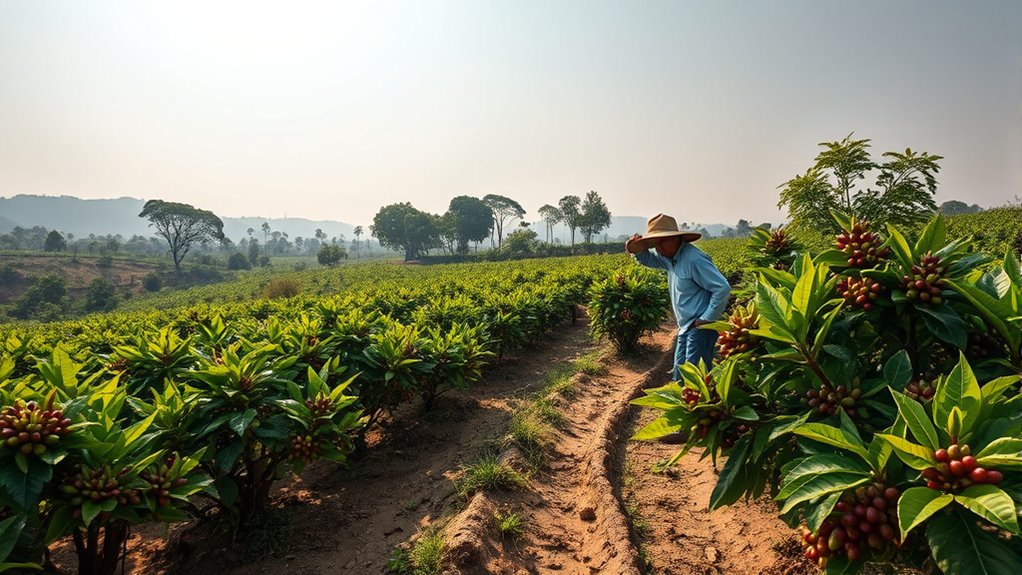
Supporting sustainable coffee practices not only benefits the environment but also guarantees that farmers are fairly compensated for their hard work.
Promoting sustainable coffee practices ensures environmental health and fair compensation for dedicated farmers.
By choosing sustainable coffee options, you can promote practices that support both the ecosystem and local communities.
Here are three effective ways to engage:
- Opt for certified products: Look for Fair Trade, Rainforest Alliance, or organic labels to secure environmental stewardship and fair wages for farmers.
- Support agroforestry: These systems enhance biodiversity and improve soil health, making coffee plants more resilient to climate stressors.
- Invest in local initiatives: Engage directly with coffee-producing communities, securing profits that remain local and fostering economic stability. Additionally, promoting sustainable farming practices can significantly reduce pesticide use and enhance the quality of coffee production.
Future Outlook for Coffee Production
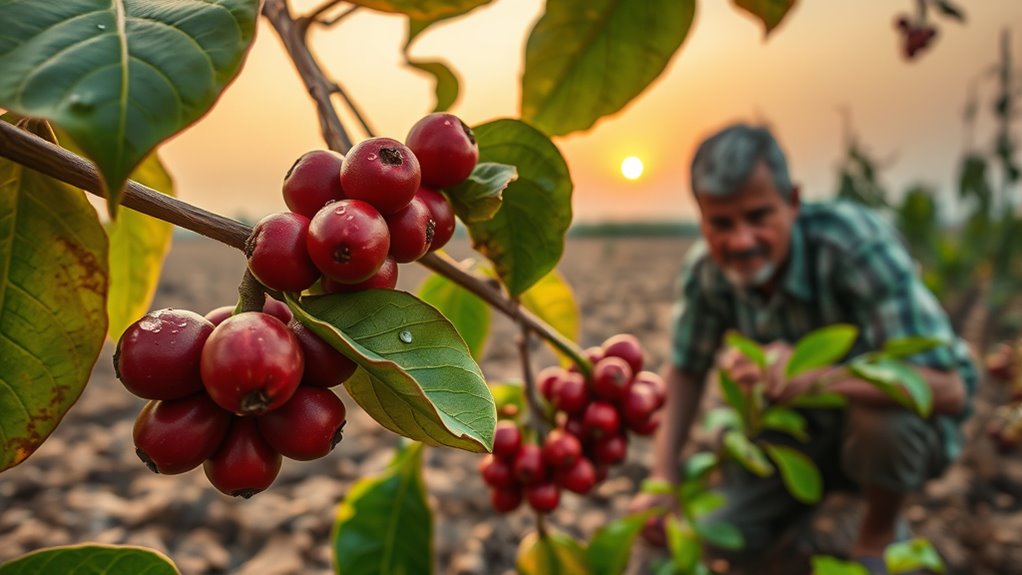
As climate change accelerates, the future of coffee production looks increasingly precarious. By 2050, suitable land for coffee cultivation could halve, drastically impacting availability. Rising temperatures and altered rainfall patterns may lead to a 50% decline in coffee yields, threatening the livelihoods of millions of smallholder farmers like you.
Increased climate hazards, such as droughts and excessive rainfall, have already been felt, with many of the most hazardous years occurring recently. This instability could push prices up, affecting local coffee shops and your daily brew.
However, ongoing research into drought-resistant coffee varieties and the promotion of sustainable farming practices can help adapt to these changes, ensuring the future supply of coffee remains viable despite the challenges posed by climate change.
Frequently Asked Questions
How Is Coffee Production Affected by Climate Change?
Coffee production’s facing significant challenges.
As temperatures rise, you’ll notice changes in flavor profiles and increased pest threats. Erratic rainfall patterns lead to longer droughts and excessive moisture, disrupting growth stages.
With suitable land shrinking, farmers like you may struggle with lower yields and higher costs. This situation jeopardizes not just your livelihood but also traditional farming practices, pushing many to move to urban areas in search of better opportunities.
How Climate Change Affects Coffee Trouble Brewing?
If you’re wondering how climate change affects coffee, it’s creating serious trouble for brewers and farmers alike.
Warmer temperatures and erratic weather are leading to lower yields and compromised quality. You might notice your favorite coffee tasting different as plants struggle under these conditions.
Plus, rising pest threats can damage crops, driving up prices. Ultimately, you could find yourself paying more for coffee that’s harder to come by, impacting your daily brew.
What Are the Environmental Issues With Coffee Production?
When you consider coffee production, several environmental issues arise.
Deforestation occurs as land is cleared for plantations, leading to habitat loss. You’ll notice that coffee farming demands significant water, often causing scarcity in local communities.
Additionally, the use of pesticides and fertilizers can degrade soil and pollute water sources.
Ultimately, improper management of wastewater from coffee processing harms aquatic life, posing serious risks to both ecosystems and human health.
How Does Climate Change Affect Production?
Climate change impacts production considerably.
You’ll notice that rising temperatures can push coffee plants beyond their ideal growth range, affecting both yield and flavor.
Changes in rainfall patterns lead to droughts or excessive rain, harming the plants and complicating harvests.
Additionally, higher temperatures encourage pests and diseases, like the coffee berry borer, to thrive, putting even more pressure on your crops.
Adapting to these changes is essential for maintaining quality and quantity in coffee production.
Conclusion
In conclusion, climate change poses a significant threat to coffee production, much like a creeping vine that chokes the life out of a tree. As temperatures rise and weather patterns shift, the future of coffee hangs in the balance. By supporting sustainable practices and embracing innovation, you can help protect this beloved beverage and the communities that depend on it. Together, we can cultivate a resilient future for coffee, ensuring it continues to thrive for generations to come.









